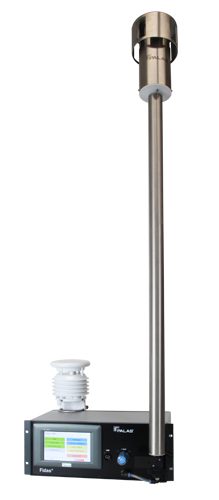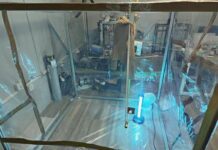
Palas, the German manufacturer of particulate monitoring instruments, says it is expanding production to cope with demand for its fine particulate monitor, the Fidas® 200, which is distributed in the UK by Air Monitors. In the following article Jim Mills explains why Air Monitors is being kept busy by the demand for this new technology.
PM monitoring – the ultimate goal
We monitor PM because of its acute health effects. It irritates our eyes and lungs, and some of the finer particles were more recently shown to be able to move directly from the nasal cavity to the brain. Monitoring is therefore essential, but there are almost as many monitoring methods as there are types of PM, so it is vitally important to monitor what matters. If you are measuring dust from a construction site, the PM is relatively large in diameter and heavy, but if you are monitoring PM from diesel emissions in a city, the smallest particles with much less mass but high particle numbers, are of greater interest. Monitoring a single size fraction provides an incomplete picture of particulate contamination and risks ignoring the PM of most interest, particularly if the ignored fractions are the finer particles that travel deepest into the lungs. The ideal PM monitor would therefore reliably and accurately monitor all important PM fractions, with high data capture rates and low service requirements… hence the heavy demand for the Fidas 200.
Continuous measurement of multiple PM types
The Fidas 200 is a fine dust ambient air quality monitoring device, developed specifically for regulatory purposes; providing continuous and simultaneous measurement of PM1, PM2.5, PM4, PM10, TSP (PMtot), as well as particle number concentration and particle size distribution between 180nm and 18µm (further non-certified size ranges are also available on request).
Employing a well-established measurement technology – optical light scattering of single particles – the Fidas 200 is equipped with a high intensity LED light source, which is extremely stable, delivering a long lifetime, with minimal service requirements. An optical aerosol spectrometer determines the particle size using Lorenz‐Mie scattered light analysis of single particles. These particles move through an optical measurement volume that is homogeneously illuminated with white light, and each particle generates a scattered light impulse that is detected at an angle of 85° to 95° degrees. The particle number measurement is based on the number of scattered light impulses, and the level of the scattered light impulse is a measure of the particle diameter.
The Fidas 200 operates with a volume flow of approx. 0.3m3/h and is equipped with a Sigma‐2 sampling head, which enables representative measurements even under strong wind conditions. The sampling system includes a drying system that prevents measurement inaccuracies caused by condensation from high humidity, which means that it will continue to function correctly in misty or foggy conditions but without the loss of semi-volatile fractions of the PM. It is also equipped with a filter holder for the insertion of a plane filter (47 or 50 mm in diameter) which enables subsequent chemical analysis of the aerosol.
Different versions of the Fidas 200 allow for stand-alone outdoors installation or for installation inside a measurement cabinet or air quality monitoring station.
Performance
The Fidas 200 is the only ambient continuous PM monitor in the UK to have passed TÜV and MCERTS. The MCERTS certificate (Sira MC16290/01) confirms that the Fidas 200 complies with the MCERTS Performance Standards for Continuous Ambient Air Quality Monitoring Systems, and with MCERTS for UK Particulate Matter. The instrument has type-approval to the Standards EN 12341 (PM10), EN 14907 (PM2.5) and is certified to the Standards EN 15267-1 and -2.
Importantly, the FIDAS 200 has half the uncertainty of many of its rivals and one third of the required uncertainty (25%).
Typical data capture rates exceed 99%. This has been achieved by a design approach that is focused on reliability. For example, two pumps operate in parallel, providing redundancy protection, and the instrument continuously monitors status and calibration.
Monitoring frequency has an adjustable time resolution ranging from 1 second up to 24 hours. However, high frequency data provides almost real-time access to readings when deployed with a remote web-enabled Envirologger. This enables the detection of short-term spikes, providing much greater insight into the causes of PM pollution.
The Fidas instruments have been proven both overseas and in the UK; Air Monitors has been supplying Fidas PM monitors for around three years and there are now over 30 monitors in operation in the UK.
Costs
One of the major financial considerations for Fidas 200 is its extremely low operating cost; the requirement for consumables is almost nil (no filter required) and its power consumption is around one fifth of its nearest rival. Calibration can be checked and adjusted, if necessary, quickly and easily in the field with a simple monodisperse powder test.
The purchase cost of a single Fidas 200 is a little more than some ambient PM monitors, but it is less expensive than others. However, for most instruments, a requirement to monitor two fractions, say PM2.5 and PM10, would necessitate two instruments and therefore double the cost. With budgets under pressure, Fidas therefore provides an opportunity to obtain better data for less cost.
In summary, the Fidas 200 offers better performance than all of its rivals; usually at significantly lower capital cost and always with dramatically lower operational costs. Consequently, it is no surprise that these instruments are selling like hot cakes.
More details can be obtained from the new website www.airmonitors.co.uk.






